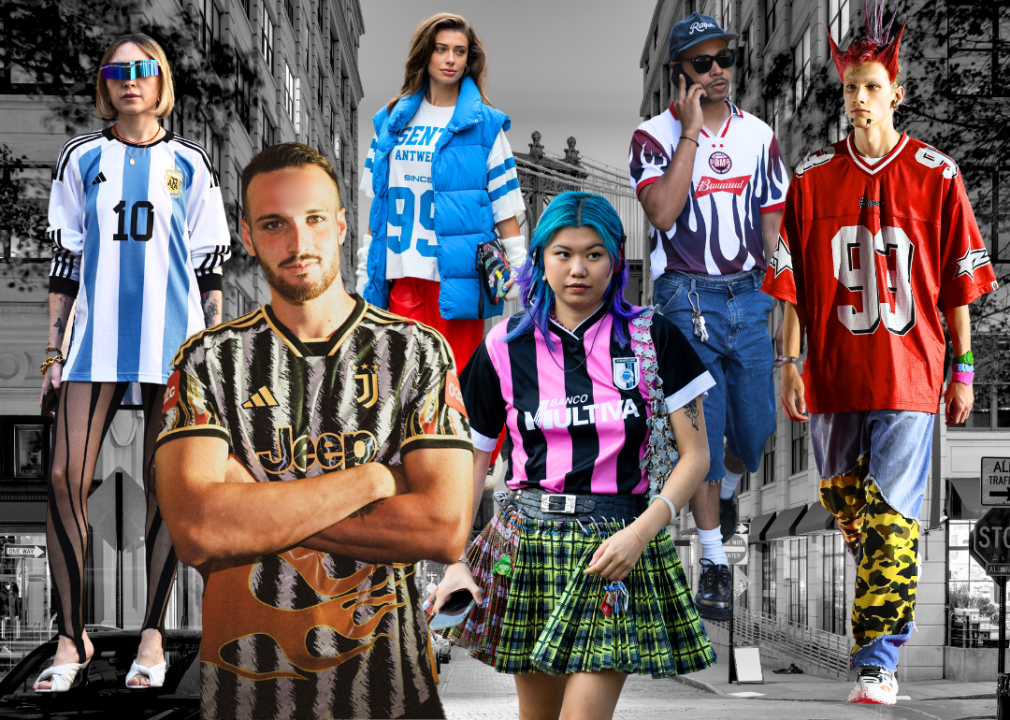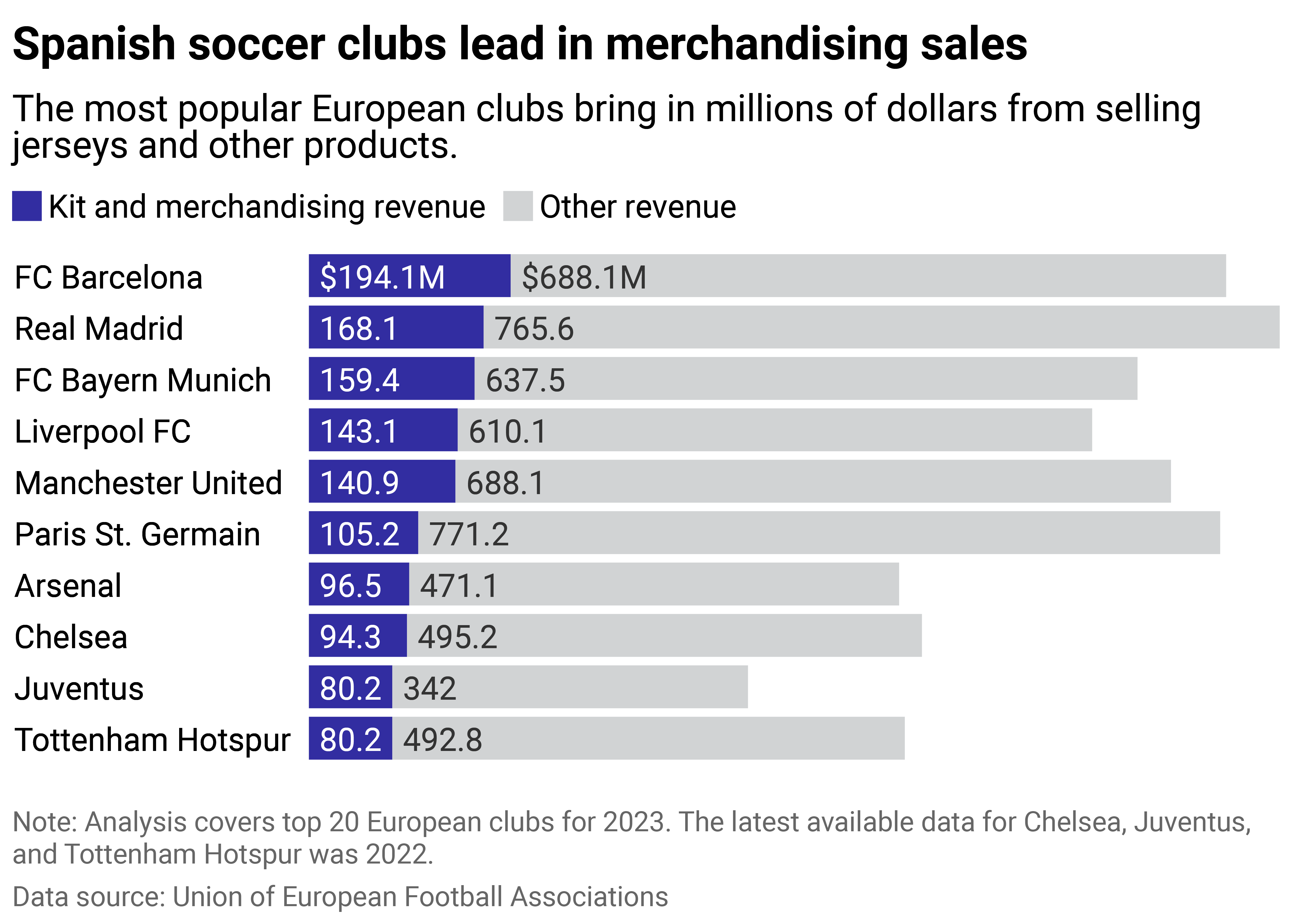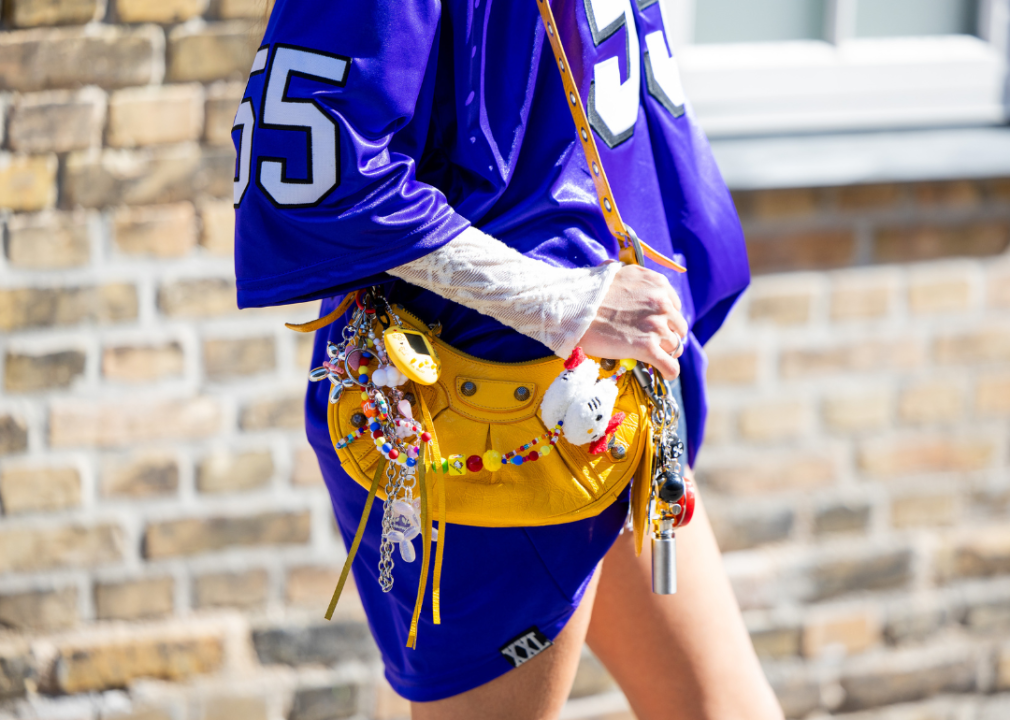Beyond blokecore: Why the intersection of football and fashion is more than a fad

Photo illustration by Michael Flocker // Stacker // Getty Images
Beyond blokecore: Why the intersection of football and fashion is more than a fad
Photo cut outs of six adults in blokecore fashion against a grayscale background of a New York City street.
Old-school soccer jerseys, bucket hats, tracksuits, and, most often, Adidas Sambas. Welcome to yet another core trend at the top of your FYP on TikTok: blokecore. Borrowing from the British colloquial term “bloke,” meaning “guy,” “man,” or “friends,” the fashion trend is built around turning football kits (“soccer uniforms” for those of us on the other side of the Atlantic) into everyday wear. It’s British football fan culture with a fashionable flair. Best of all, it’s comfort wrapped up in style. The RealReal explores the blokecore trend, how to wear it, and the hidden histories that preceded it, with help from Vogue, Vice, and Refinery29.
Blokecore has seemingly modern roots. American TikTok creator Brandon Huntley helped popularize the term in 2021 when a friend wrote “bloke” under one of his posts as a joke. The term, and the fashion sensibility, spread from there.
“Everyone’s got their Adidas shorts on, the jerseys are everywhere,” Texan-raised, London-based stylist Katelyn Cutbirth told Stacker. “I mean, it’s absolutely taking over.” Fashion brands like Etro and Venezia are getting into the action by incorporating football elements into their collections. Streetwear names like Supreme and Kith have also leaned into the trend if their drops are any indication.
One notable name in fashion has certainly done his part in pushing blokecore’s popularity: iconoclast designer Demna, who brought the Eastern European aesthetic of his youth as a Georgian refugee to high fashion. His aesthetic often resulted in unusual pairings, sometimes pairing sports with evening attire. It was less of a fashion statement and more visual evidence of geopolitical trauma.
The creative director of couture powerhouse Balenciaga since 2015, Demna revealed designs for a fictional Balenciaga Football Club, including jerseys, puffer jackets, and football shoes in 2020.
“Footballers and priests were what I grew up with in Georgia,” Demna told British Vogue after the show. Years later, in 2024, football continues to inspire the designer with a limited-edition line of jerseys and track pants emblazoned with the Balenciaga logo in neon yellow, pink, and bright white. With Balenciaga and other fashion lines fanning the blokecore flame, football club fortunes have followed.
![]()

The RealReal
Revenues for European soccer kits rise
Bar chart showing the top European football clubs that make the most money from kit and merchandising sales in 2023. FC Barcelona and Real Madrid lead followed by FC Bayern Munich and then Liverpool.
Blokecore, as a trend, has resulted in a financial windfall for many of the world’s top soccer clubs or teams. Firms like FC Barcelona and FC Bayern Munich have retailed almost $200 million and $160 million in team attire sales alone. In Europe, kits are big business.
Revenues from merchandising are now 60% above 2019 levels, according to the Union of European Football Associations, which governs professional European football. In 2022 (the latest available data), the top 20 clubs generated about 1.2 billion euros in kit and merchandising sales.
The most popular teams based on kit and merchandising sales also happen to be the clubs that earn the most revenue with the addition of well-supported teams.
Real Madrid (#2 on the list of top earners in kit and merchandising) placed first in total revenues in 2023 at 841 million euros. Manchester United placed fifth when it came to kit and merchandising revenue, as well as total revenue with 747 million euros in revenue for 2023. FC Barcelona, the top earner in kit and merchandising sales, came in third by total revenue with 815 million euros.

Christian Vierig // Getty Images
Blokecore’s erased traditions
A person, seen only from the shoulders down, wears yellow Balenciaga bag with accessories, football jersey outside.
Blokecore feels fresh and new, yet like many things in fashion, its roots go further back than most imagine. One can see threads of this trend when looking at the clothes of popular culture from the early aughts. At that time, fashion was consumed by trucker hats, expensive, logo-defined designer bags, low-rise cut pants, and a sweaty-but-chic sensibility. (Think Christina Aguilera’s “Dirrty” era.) Generation Z, young children back then, are now young adults revisiting those early looks of their youth like every generation has done.
“It’s this new mixture of using [soccer] jerseys and the same [Adidas] Sambas and the football shorts, but then mixing it with hyper-feminine, coquette-style [elements]. So girls will wear a little peasant top or a peasant skirt or a mini skirt or like their ballet flats, but with the soccer jerseys and stuff. It’s really cute,” Cutbirth told Stacker. “Girls will wear bows in their hair or Mary Janes and a cute little mini bag. I think that’s kind of how you can elevate it as well. Because you’ll wear a little Prada bag, but with the jersey and the Adidas shorts. It’s kind of high-low dressing.”
Though Demna was able to polish this trend and present it on the runway, blokecore is a style that sits firmly with the working class. In British culture, the bloke is an everyman who sits in a pub with a drink in hand, cheering his team on. Predictably, this unaffected character is what many trendsetters try to evoke whenever they pair their kits with the latest kicks.
Team pride doesn’t just exist in European countries, however. “Throughout Latin America, the Caribbean, and Latine U.S.A, Latines are always representing where they’re from—in and outside of their respective homelands—through sports jerseys. For decades, Black and Latina women have stylized fútbol, baseball, basketball, and hockey jerseys, turning our ‘hoods into fashion and identity statements,” Refinery29 writer Ashley Garcia Lezcano explained.
Lezcano further makes the case for renaming the trend “block-core,” which references the urban dwellings (like New York City, Los Angeles, and Orlando) where this trend was alive and well before its official codification.
British blokes have long used soccer as an element of dress. But it is also true that the bubbling Black and Latine cultures in cities across North and South America have concurrently used soccer motifs as a tool of daily dress and expression that shouldn’t be buried under the Eurocentric term “bloke.”
Story editing by Carren Jao. Additional editing by Kelly Glass. Copy editing by Kristen Wegrzyn.
This story originally appeared on The RealReal and was produced and
distributed in partnership with Stacker Studio.